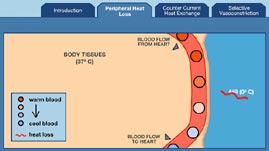Teachers' Domain - Digital Media for the Classroom and Professional Development
User: Preview

Source: University of Alberta and Bio-DiTRL
This interactive activity adapted from the University of Alberta explores heat exchange between the human circulatory system and the environment and illustrates how your body adapts its blood flow under different conditions. Animations show how peripheral heat loss, counter-current heat exchange, and selective vasoconstriction help maintain a healthy core body temperature.
Your body is constantly monitoring and adjusting its processes to maintain homeostasis—relatively stable and constant internal conditions. Your body automatically responds to changing external conditions—for example, by changing breathing or heart rate, to keep its many systems working together to maintain a healthy internal environment.
One important aspect of homeostasis is temperature regulation. To function properly, the human body needs to maintain a fairly constant temperature of about 98.6°F (37°C), give or a take a degree or two. When the human body is unable to regulate its temperature effectively, it suffers from hyperthermia (above normal body temperature) or hypothermia (below normal body temperature). If body temperature reaches significantly above or below normal, bodily functions are seriously affected and death could result.
An organism's ability to maintain its body temperature within tolerable limits is known as thermoregulation. Some animals, including most mammals and birds, are endothermic and regulate body temperature internally. In the way a thermostat regulates a heating system to keep a house at a comfortable temperature, endotherms have a biological thermostat to keep body temperature within a normal range. If body temperature changes, receptors sense the change and trigger a response to adjust.
To avoid overheating, many endotherms sweat and/or pant to cool themselves using the process of evaporation. When moisture evaporates from a body surface, it takes heat away from the body and transfers it to the environment. Alternatively, to stay warm in a cold environment, endotherms may shiver to increase heat production in muscles and erect their hair/fur/feathers, which increases the thickness of the fur or feathers, thus increasing insulation.
Other animals, such as reptiles, amphibians, and fish, are ectothermic and are not able to regulate body temperature internally. Instead, ectotherms use the environment to regulate body temperature. For example, to stay cool in a hot environment, ectotherms may stay in the shade or burrow into the ground. Alternatively, to stay warm, they may lay in the Sun or on a hot rock.
In all animals, blood that flows near the body surface exchanges heat with the environment. Depending on the temperature gradient (the direction and rate of temperature change), the blood can either lose heat to the environment or gain heat from it. By controlling the amount of blood flow and skin exposure, both endotherms and ectotherms can regulate body temperature.
Endotherms and ectotherms are sometimes referred to as warm- or cold-blooded, respectively, but those terms can be misleading: they describe the difference in the way that endotherms and ectotherms regulate body temperature, but are not descriptive of actual body temperatures. For example, some "cold-blooded" organisms can have very high body temperatures, even higher than "warm-blooded" animals.
 Loading Standards
Loading Standards Teachers' Domain is proud to be a Pathways portal to the National Science Digital Library.
Teachers' Domain is proud to be a Pathways portal to the National Science Digital Library.
